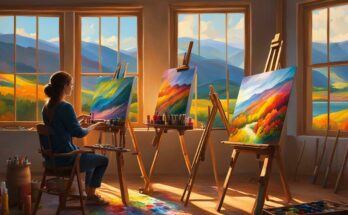Welcome to our comprehensive guide on drawing gothic images. Whether you’re a beginner or an experienced artist, this article will provide you with expert tips and techniques to create dark and alluring gothic art. With our guidance, you’ll be able to bring your gothic illustrations to life with ease.
Gothic art drawing has a unique and captivating aesthetic that has stood the test of time. By mastering the art of drawing gothic images, you’ll be able to create stunning illustrations that capture the essence of this mysterious and fascinating genre. So, let’s dive in and explore the world of gothic art!
Key Takeaways:
- Learn expert tips and techniques to create gothic art drawings.
- Understand the key elements of the gothic aesthetic.
- Master specific drawing techniques to add depth and intensity to your gothic artwork.
- Explore various subjects and themes commonly found in gothic art.
- Unleash your creativity and create stunning gothic illustrations.
Understanding the Gothic Aesthetic
Before diving into drawing gothic images, it’s important to understand the gothic aesthetic. This knowledge will help you capture the essence of gothic art in your drawings, allowing you to create mesmerizing and captivating gothic artwork.
Gothic art and design are characterized by dark and moody themes, intricate details, and symbolism. By incorporating these elements into your drawings, you can evoke a sense of mystery, darkness, and allure. Whether you’re creating goth aesthetic artwork or seeking gothic design ideas, understanding the fundamental principles of gothic art is crucial.
Dark and Moody Themes
Gothic art frequently explores dark and gloomy themes, often drawing inspiration from Gothic literature, horror, and the supernatural. Themes such as death, decay, the macabre, and the occult are common in gothic art. Use these somber themes to create an eerie and haunting atmosphere in your drawings.
Intricate Details
Intricate details play a vital role in gothic artwork. From intricate filigree patterns to ornate architectural designs, adding intricate details to your drawings can enhance the gothic aesthetic. Pay attention to the small details, such as delicate linework, intricate textures, and precise shading, to bring depth and complexity to your gothic images.
Symbolism
Symbolism is another essential element in gothic art. Certain symbols such as crosses, ravens, skulls, roses, and pentagrams are commonly associated with the gothic aesthetic. Incorporating these symbols into your drawings can add layers of meaning and evoke a sense of darkness, spirituality, or enchantment.
Quote:
“Gothic art is a captivating genre that allows artists to delve into the depths of darkness and bring forth beauty, mystery, and emotion.” – Emily Adams, Gothic Art Enthusiast
Understanding the gothic aesthetic is crucial for creating compelling gothic artwork. By immersing yourself in the dark and alluring world of gothic art, you can draw inspiration from its themes, embrace intricate details, and incorporate powerful symbolism into your drawings. Now that you have grasped the essence of gothic art, it’s time to delve into the techniques of drawing gothic images in the next section.
Mastering the Techniques
To create captivating gothic images, you need to master specific drawing techniques. In this section, we will guide you through the process of sketching dark art sketches and macabre drawings. By incorporating these techniques, such as skull motifs, intricate patterns, and ethereal figures, you can add depth and intensity to your gothic artwork.
Skull Motifs: Incorporating skull motifs is a common theme in gothic art. The key is to focus on the details and create a sense of eeriness and mystery. Pay attention to the shape of the skull, its shading, and intricate linework. Experiment with different angles and perspectives to bring your skull motifs to life.
Intricate Patterns: Intricate patterns are another hallmark of gothic art. From delicate lace-like designs to intricate filigree, these patterns add a sense of complexity and beauty to your drawings. Use fine lines, cross-hatching, or stippling techniques to create depth and texture in your patterns.
Ethereal Figures: Adding ethereal figures, such as ghosts or spirits, can enhance the haunting atmosphere of your gothic drawings. Focus on creating transparency and a sense of movement with flowing lines and wispy details. The use of light and shadow is crucial in portraying these ethereal figures effectively.
Remember, practice is key when mastering these techniques. Start with simple sketches and gradually add complexity. Experiment with different mediums, such as graphite, ink, or charcoal, to achieve the desired effect.
“The dark art of gothic sketches requires patience, attention to detail, and a willingness to explore the macabre. Embrace the shadows and let your imagination run wild as you bring your gothic visions to life on paper.” – Emily Blackwood, Artist
Now that we’ve covered the essential techniques, let’s delve into the world of gothic imagery in the next section.
| Technique | Description |
|---|---|
| Skull Motifs | Incorporating skull motifs adds a sense of darkness and mystery to your gothic drawings. Pay attention to details like shading and intricate linework. |
| Intricate Patterns | Intricate patterns, such as lace-like designs or filigree, add complexity and beauty to your gothic art. Use fine lines and shading techniques to create depth. |
| Ethereal Figures | Ethereal figures like ghosts or spirits enhance the haunting atmosphere of your gothic drawings. Focus on creating transparency and a sense of movement with flowing lines and wispy details. |
Exploring Gothic Imagery
Now that you have mastered the techniques of drawing gothic art, it’s time to dive into the captivating world of gothic imagery. In this section, we will explore a variety of spooky subjects and themes commonly found in gothic art. From haunted landscapes and mysterious castles to eerie creatures and supernatural beings, these elements will inspire you to create unique gothic sketches that evoke a sense of darkness and mystery.
Whether you prefer to sketch chilling graveyard scenes or creepy abandoned mansions, gothic imagery allows you to unleash your creativity and explore the depths of the macabre. These visuals, rich in symbolism, provide endless opportunities for creating captivating and haunting artwork.
“Gothic imagery is a reflection of the dark recesses of our imagination, where the mystical and the macabre intertwine.”
Haunted Landscapes
One of the iconic subjects in gothic art is the haunted landscape. These ethereal scenes feature dense forests, misty marshes, and crumbling ruins, creating an atmosphere of foreboding and isolation. To capture the eerie allure of these landscapes, focus on using deep, dark tones and play with atmospheric perspective to give a sense of depth and mystery. Enhance the mood by adding elements like gnarled trees, tombstones, or ghostly apparitions.
Eerie Creatures
Gothic imagery is often populated by strange and otherworldly creatures. From vampires and werewolves to ghosts and demons, these beings embody the mysterious and otherworldly nature of gothic art. To bring these creatures to life in your sketches, pay attention to details such as sharp fangs, elongated claws, and piercing eyes. Experiment with different poses and expressions to convey their essence, whether it be dangerous allure or malevolence.
Supernatural Beings
Supernatural beings are a recurring theme in gothic art, representing the boundary between the living and the afterlife. Angels, demons, and spirits often appear in gothic imagery, showcasing a delicate balance between beauty and darkness. When sketching these ethereal figures, focus on capturing their ethereal and mystical qualities through flowing garments, intricate wings, and a sense of weightlessness.
Remember, gothic imagery allows you to explore the depths of your imagination and create unique and captivating sketches. Allow yourself to embrace the darkness and let your creativity soar.

Through the power of spooky sketches and the allure of unique gothic artwork, you have the opportunity to transport viewers to a world shrouded in darkness and mystery. Let your imagination guide your hand as you bring gothic imagery to life on the page.
Conclusion
Now that you have reached the end of this comprehensive guide on drawing gothic images, you are equipped with valuable insights and techniques to create stunning gothic artwork. By exploring the gothic aesthetic, mastering the necessary techniques, and delving into gothic imagery, you have broadened your artistic horizons and tapped into a realm of dark and alluring visions.
As you continue your artistic journey, remember to experiment and push the boundaries of your creativity. Go beyond conventional styles and explore different approaches to drawing gothic images. Whether you choose to focus on spooky sketches, macabre motifs, or intricate patterns, allow your imagination to roam free and unearth the beauty within the darkness.
Your gothic illustrations have the power to evoke a sense of mystery and captivate viewers. Embrace the unique and fantastical elements that define gothic art, and let your drawings tell stories of haunted landscapes, supernatural creatures, and enigmatic symbolism. Each stroke of your pen brings your vision to life, inviting others into the eerie and enchanting world you have crafted.
Now it’s time to pick up your pencils, unleash your creativity, and immerse yourself in the mesmerizing realm of gothic art. Get lost in the shadows, embrace the unknown, and let your gothic illustrations leave an indelible mark on those who behold them.
FAQ
How can I learn to draw gothic images?
To learn to draw gothic images, it’s important to start by studying the gothic aesthetic and understanding its key elements. From there, you can practice specific techniques like sketching dark and macabre elements, incorporating intricate patterns, and capturing the essence of gothic themes. Experiment with different styles and subjects, and don’t be afraid to let your creativity shine.
Where can I find inspiration for gothic art drawings?
When looking for inspiration for your gothic art drawings, immerse yourself in gothic literature, music, architecture, and fashion. Visit gothic art exhibitions, explore online art communities, and follow gothic artists on social media platforms. Pay attention to the dark and mysterious elements in the world around you, and let them fuel your imagination and creativity.
What materials do I need to create gothic art sketches?
The beauty of gothic art is that it can be created using various mediums and materials. Whether you prefer traditional pencil and paper, digital drawing tools, or even mixed media techniques, the most important thing is to find the materials that allow you to express your dark and eerie vision effectively. Experiment with different mediums to discover your preferred tools for gothic art sketching.
How can I add depth and intensity to my gothic drawings?
To add depth and intensity to your gothic drawings, focus on creating contrasting elements. Play with light and shadow to create a moody atmosphere and emphasize certain details. Incorporate intricate patterns and textures to enhance the overall visual impact. Experiment with different shading techniques and use darker tones to enhance the macabre atmosphere of your gothic artwork.
Are there any tips for capturing the gothic aesthetic in my drawings?
Yes, there are several tips to capture the gothic aesthetic in your drawings. First, pay attention to the details and symbolism commonly associated with gothic art, such as skulls, ravens, candelabras, and ornate architecture. Incorporate these elements into your artwork to create an authentic gothic feel. Additionally, focus on creating a sense of darkness and mystery in your compositions, using techniques like dramatic lighting and dynamic poses.



